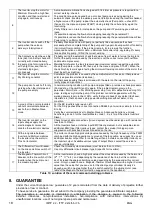
6
IMTP 2.2 - ITTP 2.2/4/5.5/7.5
ENG
5.2 Pump hydraulic connection
Connect the hydraulics according to the regulations in force.
This product can work when connected to the waterworks or taking water from a water cistern.
If you connect the system to the waterworks, you have to respect the regulations in force issued by local
authority (Common, local authority, etcÉ). It is important to put a pressure switch on the inlet leader; it switches
off the motor power in case of low pressure (it is a dry-working external protection). The inverter have two ports
for a normally-closed generic contact: EN and C on the logic board (fig. 4).
Verify the amount of pressure between the waterworks and the maximum pump pressure, does not exceed the
maximum pump pressure value (nominal pressure)
Besides, it is important to put a pressure gauge on the outlet leader, so it is possible to regulate the pressure
factory setting value, according to the real conditions of the system.
On the outlet leader it is necessary to install
a pressure gauge with an output signal between 0 – 5 Vdc or 4 – 20 mA; this signal is an input to the inverter.
As a rule it would be better to install flexible or rigid pipes on inlet and outlet branches, on-off valves on inlet and
outlet branches, a no return valve, a membrane surge tank. To avoid drying the system for replacement of the
membrane surge tank, pressure gauge or pressure transducer, it would be better to install some on-off valves
between the tank connection and the system. Put the pressure transducer downstream the non-return valve, if it
is present. It would be better to install a cock, used during the system calibration; it is not necessary if there is
an exit near the pump. Be sure the surge tank allows the system pressure.
Check the pre-stress pressure of the surge tank before connecting it to the system.
5.3 Electric connections
Check voltage and frequency of the power supply are the same of the nominal values of the control system, that
are written on the box. Be certain of having a good short-circuit protection in your electric system.
Before working, be certain all the circuit is without voltage (also the connections voltage clear). Disconnect the
inverter from the power supply before working on electrical or mechanical parts of the system.
Wait at least 2 minutes after the power supply disconnection before working on the inverter; this
allow the capacitors discharge (in order to be sure they are completely discharged, the led
placed inside the inverter, on the electronic board, have to be completely switched off).
If the local regulation about electric system provides for a magneto-thermal differential switch,
install one. Select the protection with curve for alternative current or pulsing current (type A or C).
The unit is equipped with all those technical arrangements required to ensure a good functioning under normal
situations installation.
The control system has a entry-filter and it conforms to the EMC directive, also have a current overload
protection which guarantees absolute protection when the Inverter is combined with motors that not exceed
the
maximum power.
IMPORTANT: For EMC is necessary that the power wires of control panel and motor power wires (when the
motor are separated from the inverter) are shielded type (or armoured) with individual conductors of appropriate
section (current density <= 5 A/mm2). These cables must be the minimum length necessary. The screen
conductor must be connected to the ground by both sides. On motor use the metal case for connection to the
ground of the screen.
To avoid loops that can create mass disturbances radiated (antenna effect), the motor operated by the
frequency converter must be connected on the ground individually, always with a low-impedance using the
metallic box of the machine.
The wires from power supply to frequency converter and wires from frequency converter Ð motor (if the motor is
separated to the Inverter) must be spaced as much as possible, not to create loops, not make them run parallel
less than 50 cm.
5.4 Motor-pumps phases connection
The single-phase inverter
IMTP2.2
must be
installed on asynchronous three-phase motor
with 100-240Vac 50/60 Hz voltage supply.
Phases must be configured to Delta mode if
the motor is 230V / 400V (most common
case, as in Figure 3).
Figure 3 – Delta motor phases connection






































